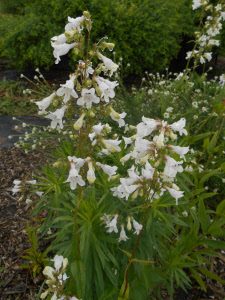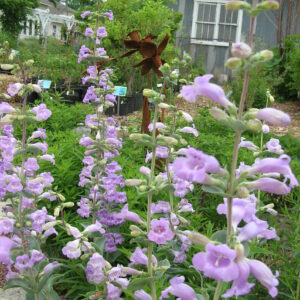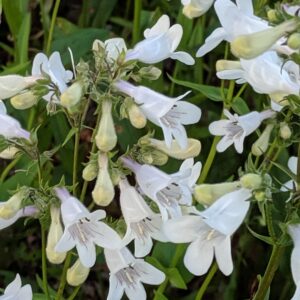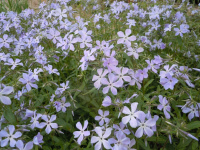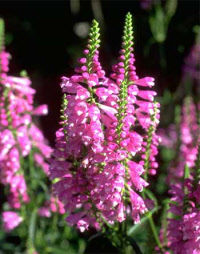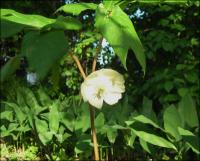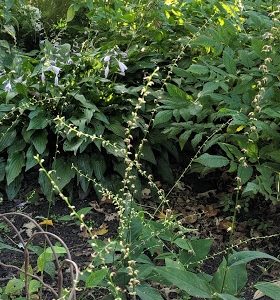Wisconsin Native
Showing 73–80 of 108 results
-
Penstemon digitalis Foxglove beardtongue Z 2-8
Palest of pink tubular bells
OUT OF STOCK
Palest of pink tubular bells in June – deadhead for rebloom. More vigorous and longer blooming than its well-known cultivar ‘Husker Red.’
Size: 24-48” x 18”
Care: sun or part shade in moist to moist, well-drained soil
Native: Maine to So. Dakota, south to Virginia and Texas and all in between, Wisconsin
Wildlife Value: host for caterpillar of Baltimore Checkerspot butterfly. Feeds several bees and hummingbirds pollen and nectar.Penstemon is named for its five stamens, penta meaning “five” in Greek. Used medicinally by the Dakota and Pawnee – to remedy chest pains, chills and fevers. P. digitalis first transported to Europe when the son of the royal Spanish gardener sent it to Kew in England, 1793.
-
Penstemon grandiflorus Large beard tongue Z 3-9 short-lived perennial that reseeds
Large pink to lavender trumpets along the 3’ stem in early summer
OUT OF STOCK
Large pink to lavender trumpets along the 3’ stem in early summer
Size: 3’ x 10”
Care: full sun in well-drained soil
Native: IL to N. Dakota, south to TX, Wisconsin
Wildlife Value: attracts Baltimore butterflyDiscovered by Thomas Nuttall, (1786-1859) who searched entire No. American continent, describing this Penstemon as “splendid and beautiful,” on his trip up the Missouri River in 1811. Cured chest pains and stomach aches for the Dakota and chills and fever for the Pawnee. Sioux made decoctions of this to remedy chills and fever and chest pain.
-
Penstemon tubaeflorus Great Plains Beardtongue 4-8
Spikes of swan white trumpets with flared ends blooms in early summer. One of most reliable, long lived penstemons.
Spikes of swan white trumpets with flared ends blooms in early summer. One of most reliable, long lived penstemons.
Size: 2-3’x 15”
Care: Sun in well-drained to moist well-drained soil
Native: Central Plains N., S. to TX & NE to Maine, Wisconsin native
Wildlife Value: feeds Baltimore butterfly, other butterflies, bees and hummingbirdsPenstemon is named for its five stamens, penta meaning five and stemon meaning stamen in Greek. Collected by English botanist Thomas Nuttall (1786-1859) who searched entire No. American continent – parts of Canada, from New England west to Oregon, parts of the South, Midwest, the Plains, the S.E., California & Hawaii, finding hundreds of new plants.
-
Phlox divaricata Wild sweet William Z 3-8
Bright lavender flowers, tubes with flat lobes, welcome spring. One of internationally known garden designer Piet Oudolf’s 100 “MUST HAVE” plants, Gardens Illustrated 94 (2013)
Bright lavender flowers, tubes with flat lobes, welcome spring. One of internationally known garden designer Piet Oudolf’s 100 “MUST HAVE” plants, Gardens Illustrated 94 (2013)
Size: 12" x 10"
Care: part shade in moist, well-drained soil.
Native: Quebec to Wisconsin south to North Carolina & Alabama
Wildlife Value: attracts hummingbirds
Awards: Received England’s Royal Horticultural Society Award of Merit.Phlox is Greek meaning “flame.” 1st introduced to gardens by Quaker explorer and nurseryman John Bartram (1699-1777) around 1746. Recommended by Gertrude Jekyll, mother of mixed perennial borders, in 1908.
-
Physotegia virginiana Obedient plant Z 3-9
Purplish red to rosy pink spikes of hooded snapdragons
OUT OF STOCK
Purplish red to rosy pink spikes of hooded snapdragons July to September
Size: 3' x 3' and spreading
Care: sun in moist to moist well-drained soil. Deer resistant and tolerates Walnut toxins
Native: Quebec to Manitoba, TX to GA, Wisconsin native
Wildlife Value: attracts hummingbirdsCollected before 1750. Called Obedient plant because if you push a flower it will remain in place temporarily – like a child who stays in the corner until you’re not looking.
-
Podophyllum peltatum Mayapple, Hog apple, Mandrake Z 4-9
White waxy cups in spring. Ephemeral, dies back in summer.
White waxy cups in spring. Ephemeral, dies back in summer.
Size: 18" x 4' spreading by rhizomes
Care: moist well-drained soil in full to part shade.
Native: Quebec to Minnesota, south to Florida & Texas, Wisconsin nativeNamed for its supposed resemblance to a duck’s foot (Anapodophyllum.) Mayapple root used medicinally by Native Americans – for the Iroquois & Delaware as a laxative and purgative, to purify the body and expel worms. Cherokee and Menomonee made the root’s juice to protect corn and potatoes from insects. Oneidas made a poltice for sores – cut every joint of root & bake half a day until brown then add water. Roots also used by Native Americans and early settlers as a purgative, emetic, “liver cleanser,” worm expellant, and to remedy jaundice, constipation, hepatitis, fevers and syphilis. Introduced 1664. You can hunt Morel mushrooms when Mayapples bloom.
-
Polemonium reptans Greek valerian, Jacobs ladder Z 4-8
Cluster of light blue bell shaped blooms in May and June
Clusters of light blue bell shaped blooms in May and June
Size: 8-12” x 10”
Care: part shade in moist to moist well-drained soil, immune to Walnut toxins
Native: Ontario & Quebec to Alabama, west to MN & KS, Wisconsin nativeCollected for gardens before 1750. Meskwaki made a compound of roots as a physic and for urinary ailments.
-
Polygonum virginianum syn. Persicaria virginiana Jumpseed Z 4-8
Arresting tiny white flowers atop nearly leafless stems blooming late summer into fall; dark green foliage marked with a maroon chevron on each leaf
OUT OF STOCK
Arresting tiny white flowers atop nearly leafless stems blooming late summer into fall;
dark green foliage marked with a maroon chevron on each leafSize: 2-3’ x 3-4’
Care: shade to part shade in moist to moist well-drained soil
Native: All eastern areas from central Canada south to Texas, Wisconsin native
Wildlife Value: attracts birds, bees & butterflies, Deer resistant
Size: Cherokee made a hot infusion of leaves with the bark of a Honey Locust to treat whooping cough.Linnaeus 1753.

